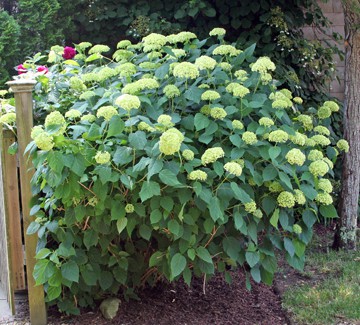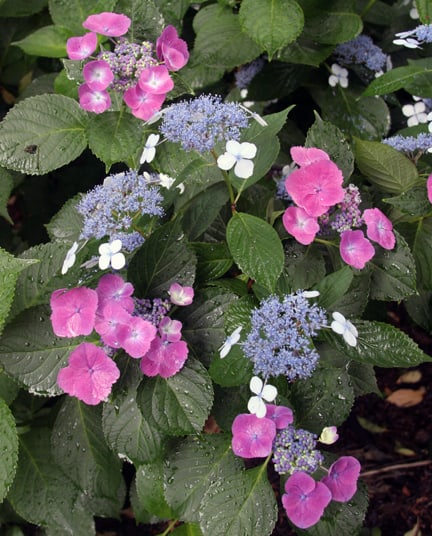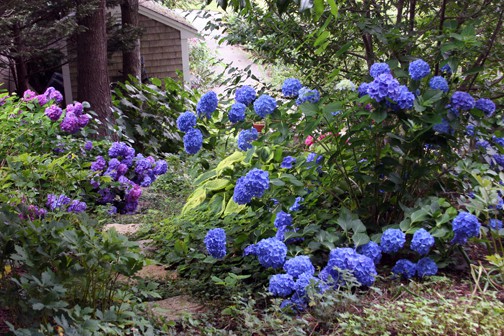
Annabelle is one of the hydrangeas that bloom on new growth. They will still flower if heavily pruned, however, and if cut down too far the new growth that results may be weak and bend under the weight of the flowers.
It’s the question I’m asked most frequently on GardenLine: “How do I prune my hydrangeas?” The problem is that the big-leaf hydrangeas, Hydrangea macrophylla, form their flower buds in the previous summer, so if you cut them short they don’t bloom very much the following summer. Most of the popular blue mop-head and blue, pink or white lace-cap hydrangeas form flowers on old growth.
Not all hydrangeas bloom on second year growth, however, and this adds to the confusion. The very hardy Pee Gee hydrangea, Hydrangea paniculata ‘Grandiflora’, blooms on new growth as does the white-flowering ‘Annabelle’ hydrangea. There are also several varieties that bloom on both new and old growth, such as ‘Penny Mac’, ‘All Summer Beauty’, and Endless Summer.
Before addressing how to prune these shrubs, let’s talk about why you should prune them. Unfortunately, many people want to make them smaller, which is the worst reason to prune a plant. Unless you’re growing a shrub or tree in a bonsai dish, you’re doomed to lose.
In general, plants should be pruned to improve appearance not control size. I repeat that because it’s important: Hydrangeas should be pruned to improve appearance, not control size. The mature hydrangea is a shrub that cannot be made smaller. If you cut a big leaf hydrangea down one year it will replace that growth the following season. If you want to keep them small, replace your larger growing variety with one that is genetically programmed to stay short…a few varieties are suggested later in this article.

Many lacecap hydrangeas bloom on second year growth, so they should be pruned in the same way as the mopheads. Download the pdf sheet at the end of this article for pruning instructions with illustrations.
The big leaf hydrangeas, lace-caps and mop-heads, should be pruned as follows:
1. Prune in the spring when the plant has begun breaking dormancy. At this time of year you can see which canes are living and which are dead.
2. Begin by removing all dead canes, cutting them down to the ground. This is best accomplished by sitting next to the plant so you’ll not be tempted to leave ugly, six inch tall stumps because you can’t reach to cut them further.
3. Once all dead canes are removed, evaluate what is left. If still you have many living stems, and some of them are over three years old, remove a third of those oldest canes, again cutting them at ground level. This will stimulate new growth. If the plant is not congested with a number of older stems, skip this step and go onto #4.
4. Neaten the plant by clipping off any old flowers that remain. Cut remaining canes back by working from the top down, stopping and making the cut just above the first or second pair of buds you come to. Using this top down method, some canes will be cut very little or not at all, while some will have living buds only near the base of the plant so you’ll be removing quite a bit of that stem.
5. Next, step back and look at the plant. If there is one stem that is a great deal taller than the rest, clip it to be in scale with the rest if you prefer how that would look. If there are any curvy, weak looking branches that trail on the ground, remove those.
6. Keep in mind that any green buds you remove have the potential to develop flowers later in the summer. Do you want a neater plant or more flowers? Remember that you could always cut those flowers for bouquets thus tidying the plant later in the season.
7. Prune Endless Summer and other big leaf hydrangeas that bloom on new growth in the same way. These plants bloom on new and old wood, so cutting them short results in fewer flowers.
8. Want to keep them small? Give it up. Plant ‘Mathilda Gutges’, my personal favorite hydrangea, or ‘Hortensis Compacta’, or the very short ‘Pia’ and ‘Pink Elf’.

‘Mathilda Gutges’ hydrangeas, here on the right, stay under four feet high, making it a good plant for foundation plantings and perennial gardens. The ‘Ami Pasquier’ hydrangea shown on the left grows over five feet high, so should be planted where it can get tall.
Pruning Hydrangeas That Bloom on New Growth
There are many ways to prune ‘Pee Gee’ hydrangeas. Some encourage them to become small trees by removing deadwood and annually removing a third of the smaller lateral branches from the ground up. By taking off these twigs and leaving the larger, upright stems, you encourage the plant to grow taller and take on the shape of a multi-stemmed small tree. After removing the deadwood and those lower stems, cut out any crossed branches or those that are growing into the center of the plant rather than away from the middle. Do this in the late winter or spring.
Pee Gee hydrangeas can also be cut down to between six inches or three feet tall every year. This tends to encourage thick growth on the top, however, and the new stems that result will be pulled down by the weight of the flowers. In general, it might be best to plant Pee Gee hydrangeas where they can get large. If you want a white flowering plant that stays small, consider the small oak leaf hydrangea, Hydrangea quercifolia ‘Pee Wee’.
Annabelle hydrangeas can also be cut short, but again, the newer growth will be weaker and the stems will bend with the weight of the flowers. I recommend pruning these as you would the mopheads.
Take pruning information into the garden with you by downloading this pdf of instructions with illustrations.
how_to_prune_hydrangeas.pdf
